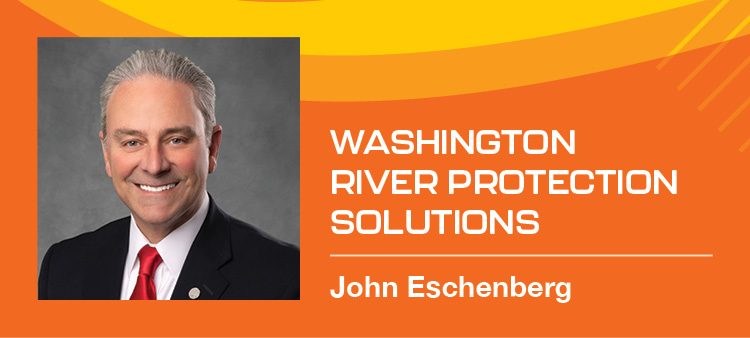
Home » WRPS finds success through grit and resilience despite past year’s obstacles
WRPS finds success through grit and resilience despite past year’s obstacles

April 13, 2022
The Tri-Cities Area Journal of Business’ “Hanford edition” is a publication I look forward to every year. This is an opportunity to recognize our workforce and thank our community partners who enable our success as the U.S. Department of Energy’s (DOE) tank operations contractor on the Hanford site.
In 2021, our success was unmatched. Never before in our 13 years at Hanford have we delivered so much for our DOE customer, stakeholders and community. Our employees remain honored by having the privilege to accomplish this meaningful work, during some of our country’s most trying times.
Our workforce of 3,000 employees and subcontractors adapted to changing workplace conditions, in response to the Covid-19 pandemic, to safely advance our critical work managing 56 million gallons of highly radioactive and chemical waste stored in Hanford’s 177 underground tanks. We redeployed resources as necessary, shifted schedules and increased our pace of operations to ensure we met our commitments for our client and community.
Making history
That allowed us to make history here at Hanford earlier this year. In January, we began the site’s first-ever large-scale tank waste treatment effort.
Over three years, during a historic pandemic, our team delivered the Tank-Side Cesium Removal (TSCR) system on time and on budget. The TSCR system is a key component of the Hanford mission to treat tank waste using the Direct-Feed Low-Activity Waste (DFLAW) program.
TSCR filters out undissolved solids and uses an ion exchange system to remove cesium from radioactive and chemical tank waste. We have now begun work toward our goal of processing 1 million gallons of waste through TSCR so that it can be staged in a double-shell tank in preparation for direct-feed to the Waste Treatment and Immobilization Plant’s Low-Activity Waste Facility when it comes online by the end of 2023.
At the Effluent Treatment Facility, our team completed a series of upgrades in 2021 and treated about a million gallons of wastewater from site operations. Now that the campaign is over, we are embarking on another series of upgrades at that facility to add capacity and efficiency needed to treat the condensate produced through DFLAW.
WRPS’ award-winning physiological monitoring program protected employees during the summer’s record-setting heat. This allowed us to complete critical work, like replacing a cover on a wastewater storage basin, even as surface temperatures in the basin reached 140 degrees. I cannot tell you how impressed I am by this hearty group of employees that safely worked in conditions many of us simply can’t imagine.
Single-shell tank progress
This year, we will complete retrieving waste from the site’s 20th single-shell tank.
The WRPS team has become very adept at safely retrieving and transferring waste from older single-shell tanks to double-shell tanks for safe storage until it can be treated.
We also are installing the needed infrastructure to retrieve waste in other tank farms, allowing us to seamlessly advance this critical risk-reduction priority. Simultaneously, our robust tank integrity program develops and deploys unique robotic systems to inspect our tanks visually and ultrasonically on a regular basis.
In the coming year, we are also scheduled to finish needed upgrades to the 242-A Evaporator, enabling us to create more valuable storage space in our double-shell tank system. We also plan to begin preparatory work to install an asphalt surface barrier on U Farm, the fifth tank farm that will have a surface barrier preventing rain and snowmelt from driving existing contamination in the soil toward the groundwater.
Safety records
We can achieve these accomplishments safely because we maintain one of the best safety records across the DOE Environmental Management complex. In 2021, we received nine external awards, recognizing our commitment to safety, quality assurance and environmental excellence. In late 2021, the Association of Washington Business honored WRPS as its Employer of the Year, recognizing our innovative job retention, creation, benefits and compensation plans that foster a thriving work environment.
We could not be a stellar employer or key contributor of the DOE Hanford cleanup mission without our community partners. Since the beginning of our contract in 2008, we have issued more than $1.8 billion in subcontracts to businesses in Benton, Franklin and Yakima counties. We also have donated more than $8 million to programs and initiatives that we believe improve the quality of life for all of us who call the Mid-Columbia region home.
We live in a great community and remain fortunate to be able to execute this mission that is important to us all.
We faced several obstacles in 2021. I am proud to say we not only overcame them; we greatly exceeded them through resilience, determination and pure grit.
With this attitude and proof of performance, we’ve set the foundation for a tremendous 2022, advancing sitewide 24/7 waste treatment operations, waste retrieval, infrastructure upgrades and supporting the small businesses and community organizations that make this region so special.
John Eschenberg is president and chief executive officer of Washington River Protection Solutions.
Editor’s note: John Eschenberg will leave Washington River Protection Solutions in May for a position at Central Plateau Cleanup Co., where he is succeeding Scott Sax, who is retiring. Eschenberg will be succeeded at WRPS by Wes Bryan.
Hanford
KEYWORDS april 2022




